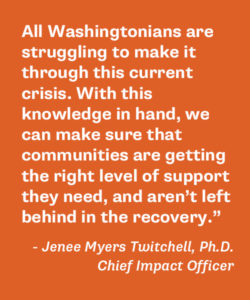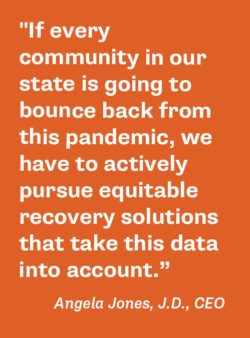Shared Crisis, Uneven Impact
COVID-19 has wreaked havoc on the lives of hundreds of millions of Americans across the country—many have died as a result, others are suffering economic hardship, food insecurity, and ongoing health issues. This crisis is also having dramatic impacts on Washington’s education systems. From school closures, distance-based learning in k-12 education, meal program shortages, to higher education institutions transitioning to online classes this fall, the virus has forced our state, along with the rest of the country, to make drastic changes in order to try and center the health of our community while continuing to educate our youth.
Washington STEM’s Expertise
But how exactly does this intersect with the work of Washington STEM? The heart of what we do is strengthen our education systems so that students furthest from opportunity have the STEM resources, tools, and support they need to thrive in our innovation-driven economy. Based on our own data analysis and reporting, Washington was already struggling to provide an equitable STEM education for all students in our state. That’s not to say that there aren’t amazing things happening in every corner of our state – our STEM Network partners have proven time and time again that communities can come together to create equitable STEM education and opportunities. However, COVID-19 has, as many others have noted, laid bare existing inequities and exacerbated them with startling clarity.
 As the pandemic unfolded, and it became clear that it was going to have a deep and sustained impact on our community, Washington STEM worked to try and identify a way to harness our skillset and resources to support our state during this time. Our Impact Team, Jenee Myers Twitchell, Ph.D. and Mikel Poppe, began developing a new data tool that pulls information and publicly available data from Washington Employment Security Department (WESD) unemployment figures, micro-census data, and job-wage data.
As the pandemic unfolded, and it became clear that it was going to have a deep and sustained impact on our community, Washington STEM worked to try and identify a way to harness our skillset and resources to support our state during this time. Our Impact Team, Jenee Myers Twitchell, Ph.D. and Mikel Poppe, began developing a new data tool that pulls information and publicly available data from Washington Employment Security Department (WESD) unemployment figures, micro-census data, and job-wage data.
Our primary goal was to determine which communities are being impacted most heavily by COVID-19. More specifically, what was unemployment data from the Washington Employment Security Department telling us? Were certain communities impacted more than others? What industries, STEM or otherwise, have been significantly affected? How were professionals with STEM jobs faring amidst the economic shut-down? Does the level of one’s education make a difference?
“It’s critical that we use data, evidence, and rigorous analysis to see who’s been disproportionally affected by the COVID-19 pandemic. All Washingtonians are struggling to make it through this current crisis. With this knowledge in hand, we can make sure that communities are getting the right level of support they need, and aren’t left behind in the recovery,” said Jenee Myers Twitchell, Ph.D.
On June 29, The Seattle Times released a full feature story on the economic impacts of COVID-19 and heavily featured our data tool and analysis. Together, here’s what we found:**
COVID-19 Impact Data
- STEM jobs are more insulated from COVID-19 – they make up 7% of unemployment claims in Washington, and yet make up 14% of jobs in the state.
- Jobs requiring STEM literacy are also more insulated from the impacts of COVID-19. Only 14% of unemployment claims come from these jobs, and yet they make up 19% of jobs in Washington.
- COVID-19 is having disproportionate impacts on Black and Brown communities:
- In King County:
- Black Washingtonians make up 6% of the population in King County but make up 11% of the unemployment claims.
- Latinx Washingtonians make up 8% of the population in King County but make up 9% of the unemployment claims.
- Pacific Islanders only make up 1% of the population in King County but make up 2% of the unemployment claims.
- Over time, we’re seeing the ongoing COVID-19 recovery widening the unemployment gaps in communities of color across the state.
- At the onset of the pandemic, Black Washingtonians filed 4% percent of unemployment claims. As of July 11, that number has increased to 6%.
- Latinx Washingtonians initially filed 11% percent of unemployment claims. As of July 11, that number has increased to 12%.
- Indigenous Washingtonians initially filed 1% percent of unemployment claims. As of July 11, that number has increased to 2%.
- Pacific Islander Washingtonians initially filed 1% percent of unemployment claims. As of July 11, that number has increased to 2%.
- White Washingtonians across the state are recovering more quickly. At the onset of the pandemic, they filed 65% percent of unemployment claims, and yet they make up 72% of the population. As of July 11, the number of jobless claims for this group decreased to 60%.
- Workers with a bachelor’s degree or higher have been insulated from the unemployment impacts of COVID-19. These credential holders make up 35% of Washington’s workforce but have only filed 21% of unemployment claims.
- In King County:
Where do we go from here?
 What does all of this tell us? One of the most significant things the data tell us is that people who were disproportionately impacted in our community around employment, education, health care access, and other systems prior to the onset of the pandemic are also those filing a disproportionate number of unemployment claims. COVID-19 is deepening the disproportionate unemployment rate that Black and Brown Washingtonians are experiencing, relative to their White counterparts.
What does all of this tell us? One of the most significant things the data tell us is that people who were disproportionately impacted in our community around employment, education, health care access, and other systems prior to the onset of the pandemic are also those filing a disproportionate number of unemployment claims. COVID-19 is deepening the disproportionate unemployment rate that Black and Brown Washingtonians are experiencing, relative to their White counterparts.
“It’s clear from what we’ve found, and the trends that we’re seeing, that we must continue to review this data on an ongoing basis to see how the COVID-19 recovery is rolling out across the state. Existing inequities are widening. Black and Brown communities aren’t seeing employment return as quickly. If every community in our state is going to bounce back from this pandemic, we have to actively pursue equitable recovery solutions that take this data into account,” said Washington STEM CEO, Angela Jones, J.D.
Prior to the onset of COVID-19, we knew that careers in our state that require STEM skills were abundant, growing, and offer some of the best jobs and wages across Washington. We also knew that education and credentials beyond high school are critical to accessing pathways to promising careers. Now, with this current crisis, these facts have only been made stronger by the evidence and data before us. STEM-related careers form a significant portion of our state’s economy and COVID-19 isn’t going to change this. What we need to do is ensure that the system is also serving Black, Brown, and Indigenous students, rural students, and girls and that these pathways to prosperity are shared and more people can benefit from the level of security STEM jobs provide that few other sectors can tout.
With this information in-hand, Washington STEM and our partners can make better, smarter decisions. We can more authentically engage with the communities we seek to serve. We can more acutely pinpoint where we can lend our expertise in support of Washington students in a COVID-19 world. But perhaps most importantly, we’re moving forward with an even sharper focus and the will necessary to ensure our education system is just and equitably serving every Washington student.
**Data and figures updated July 11, 2020